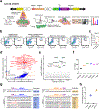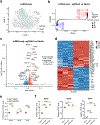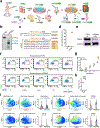In vivo CRISPR screening in CD8 T cells with AAV-Sleeping Beauty hybrid vectors identifies membrane targets for improving immunotherapy for glioblastoma
- PMID: 31548728
- PMCID: PMC6834896
- DOI: 10.1038/s41587-019-0246-4
In vivo CRISPR screening in CD8 T cells with AAV-Sleeping Beauty hybrid vectors identifies membrane targets for improving immunotherapy for glioblastoma
Abstract
Targeting membrane proteins could improve the efficacy of T cell-based immunotherapies. To facilitate the identification of T cell targets, we developed a hybrid genetic screening system where the Sleeping Beauty (SB) transposon and single guide RNA cassette are nested in an adeno-associated virus (AAV). SB-mediated genomic integration of the single guide RNA cassette enables efficient gene editing in primary murine T cells as well as a screen readout. We performed in vivo AAV-SB-CRISPR screens for membrane protein targets in CD8+ T cells in mouse models of glioblastoma (GBM). We validated screen hits by demonstrating that adoptive transfer of CD8+ T cells with Pdia3, Mgat5, Emp1 or Lag3 gene editing enhances the survival of GBM-bearing mice in both syngeneic and T-cell receptor transgenic models. Transcriptome profiling, single cell sequencing, cytokine assays and T cell signaling analysis showed that Pdia3 editing in T cells enhances effector functions. Engineered PDIA3 mutant EGFRvIII chimeric antigen T cells are more potent in antigen-specific killing of human GBM cells.
Conflict of interest statement
Competing interests declaration
A patent application has been filed related to the data in this manuscript.
Figures






Similar articles
-
Applications of CRISPR-Cas9 Technology to Genome Editing in Glioblastoma Multiforme.Cells. 2021 Sep 7;10(9):2342. doi: 10.3390/cells10092342. Cells. 2021. PMID: 34571991 Free PMC article. Review.
-
CRISPR targeting of mmu-miR-21a through a single adeno-associated virus vector prolongs survival of glioblastoma-bearing mice.Mol Ther. 2025 Jan 8;33(1):133-151. doi: 10.1016/j.ymthe.2024.11.023. Epub 2024 Nov 19. Mol Ther. 2025. PMID: 39563028
-
Effect of CRISPR/Cas9-Mediated PD-1-Disrupted Primary Human Third-Generation CAR-T Cells Targeting EGFRvIII on In Vitro Human Glioblastoma Cell Growth.Cells. 2020 Apr 16;9(4):998. doi: 10.3390/cells9040998. Cells. 2020. PMID: 32316275 Free PMC article.
-
Targeting GDF15 to enhance immunotherapy efficacy in glioblastoma through tumor microenvironment-responsive CRISPR-Cas9 nanoparticles.J Nanobiotechnology. 2025 Feb 20;23(1):126. doi: 10.1186/s12951-025-03182-8. J Nanobiotechnology. 2025. PMID: 39979966 Free PMC article.
-
Unlocking Glioblastoma Vulnerabilities with CRISPR-Based Genetic Screening.Int J Mol Sci. 2024 May 23;25(11):5702. doi: 10.3390/ijms25115702. Int J Mol Sci. 2024. PMID: 38891890 Free PMC article. Review.
Cited by
-
Deep learning explains the biology of branched glycans from single-cell sequencing data.iScience. 2022 Sep 19;25(10):105163. doi: 10.1016/j.isci.2022.105163. eCollection 2022 Oct 21. iScience. 2022. PMID: 36217547 Free PMC article.
-
Local therapy in glioma: An evolving paradigm from history to horizons (Review).Oncol Lett. 2024 Jul 17;28(3):440. doi: 10.3892/ol.2024.14573. eCollection 2024 Sep. Oncol Lett. 2024. PMID: 39081966 Free PMC article. Review.
-
Comprehensive analysis and validation of SNX7 as a novel biomarker for the diagnosis, prognosis, and prediction of chemotherapy and immunotherapy response in hepatocellular carcinoma.BMC Cancer. 2023 Sep 25;23(1):899. doi: 10.1186/s12885-023-11405-0. BMC Cancer. 2023. PMID: 37743471 Free PMC article.
-
Synthetic immunity by remote control.Theranostics. 2020 Feb 19;10(8):3652-3667. doi: 10.7150/thno.41305. eCollection 2020. Theranostics. 2020. PMID: 32206114 Free PMC article. Review.
-
Applications of CRISPR-Cas9 Technology to Genome Editing in Glioblastoma Multiforme.Cells. 2021 Sep 7;10(9):2342. doi: 10.3390/cells10092342. Cells. 2021. PMID: 34571991 Free PMC article. Review.
References
-
- Chen DS & Mellman I Oncology meets immunology: the cancer-immunity cycle. Immunity 39, 1–10 (2013). - PubMed
-
- Kvistborg P et al. Anti-CTLA-4 therapy broadens the melanoma-reactive CD8(+) T cell response. Science Translational Medicine 6 (2014). - PubMed
-
- Ribas A Tumor Immunotherapy Directed at PD-1. New Engl J Med 366, 2517–2519 (2012). - PubMed
Publication types
MeSH terms
Substances
Grants and funding
LinkOut - more resources
Full Text Sources
Other Literature Sources
Research Materials
Miscellaneous

